Growing your company in a world where technology and markets are always changing means using your team's complete skill set and knowing what skills you have and what you'll need soon.
Here's an easier way to think about it:
Your team is great and ready for big challenges. But, if you're not sure what each person is good at, you might not use their abilities well, and the results might not be as good as you hoped.
This is where workforce planning software comes in. These tools make it easier to keep track of each person’s skills. They help you plan who works on what projects, move people within the company, plan for future leaders, and set up training - all based on data.
Strategic workforce planning tools or enterprise workforce planning software makes teamwork better, planning more effective, and helps you focus on the most important tasks.
That being said, we understand it can be tough for Chief Human Resources Officers (CHROs) and other leaders to pick the best workforce planning tools. There are so many choices, all with different features. But don't worry. We've done the research for you.
In this blog, we'll show you the top sixteen workforce planning tools of 2025.
Whether your business is just starting or already well-established, these tools will improve the way you plan and organize your team's work.
Let's dive in!
|
Table of contents |
Top 16 Workforce Planning Software of 2025
1. iMocha
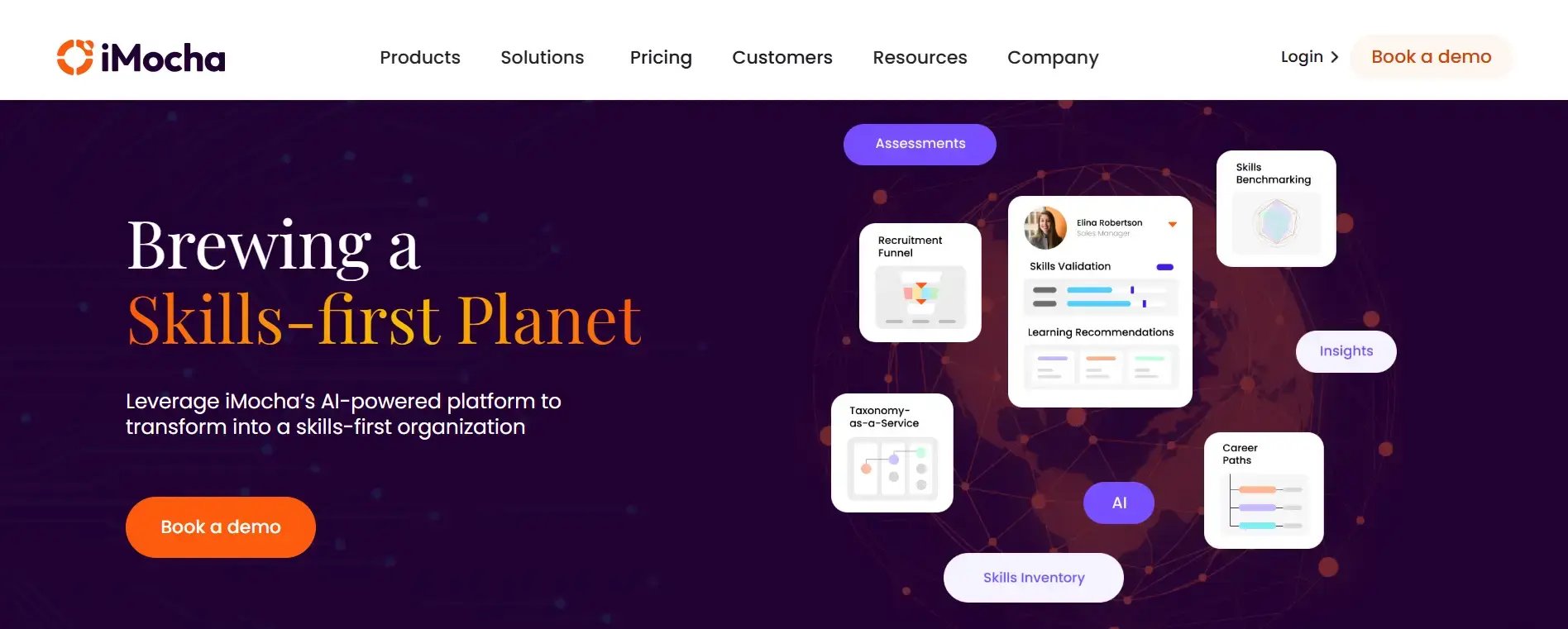 iMocha is an advanced AI-powered Skills Intelligence Cloud that elevates the benefits of a traditional enterprise workforce planning software to a whole new level using a ‘Skills-First’ approach.
iMocha is an advanced AI-powered Skills Intelligence Cloud that elevates the benefits of a traditional enterprise workforce planning software to a whole new level using a ‘Skills-First’ approach.
It assists companies in creating a skill-centric, data-driven environment for hiring, training, and managing talent effectively and at a large scale, suitable for any job or industry.
Over 500 companies in more than 70 countries use iMocha’s Skills Intelligence to focus on skill-based workforce management, create unbiased learning and development programs, and map the employee lifecycle from recruitment to retirement.
iMocha’s versatile enterprise workforce management software works for various industries, including IT, Telecom, BFSI, automobiles, high-tech, and more. It helps these sectors make informed talent decisions based on data and free from any sort of biases or speculations.
iMocha uses patented technology and innovative features. It creates detailed job architectures, profiles of employee skills, an inventory of organizational skills, and frameworks like skills taxonomy and ontology. It sets skill benchmarks and provides detailed people analytics. This aids in hiring, developing, and managing talent based on factual data instead of guesses.
Key Features:
- Skill Index: Measures skill proficiency at different levels – individual employees, teams, business units, and the whole organization.
- Skills Benchmarking: Compares your workforce's skills with industry norms.
- Easy Integration: Works smoothly with SAP SuccessFactors and other traditional Applicant Tracking Systems (ATS) and Learning Management Systems (LMS).
- Multi-Channel Approach to Skills Intelligence: Evaluates employee skills using various sources within the organization.
- Comprehensive Job Architecture: Tracks and monitors the available skills and those needed for specific job roles.
Founding Year: 2015
G2 Rating: 4.4/5 (261 reviews)
Pricing: Click here for more details
2. Vena
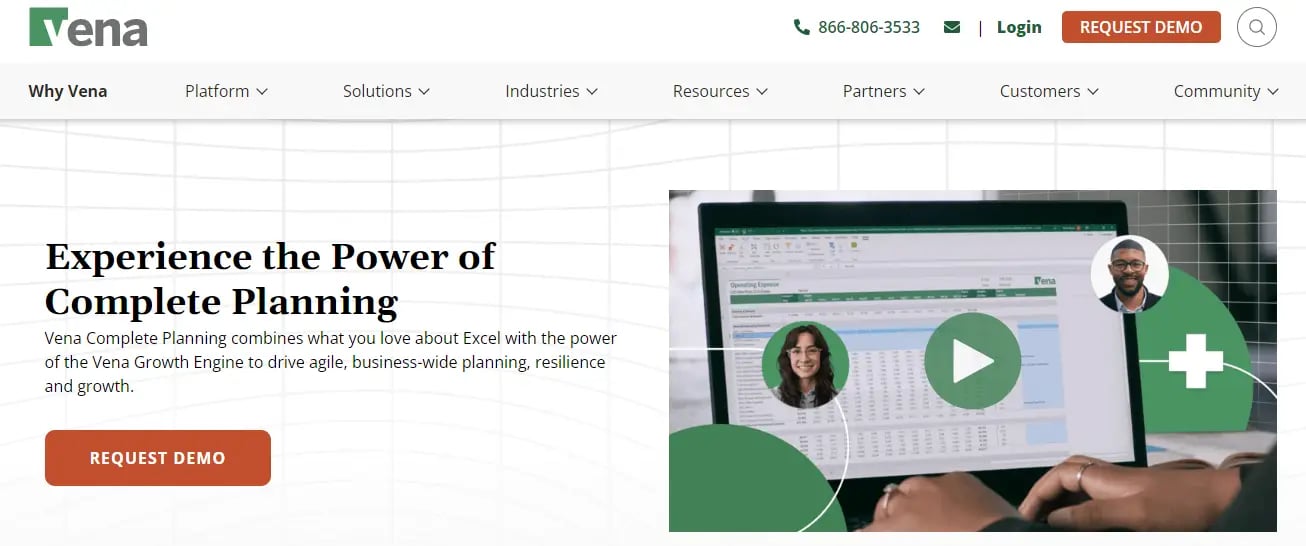 Vena is a unique strategic workforce planning tool that motivates and equips business leaders, finance, and operations experts to Plan To Grow™. It combines the well-known ease and adaptability of Excel with the Vena Growth Engine, a SaaS platform and approach that drives your planning process and supports your growth journey.
Vena is a unique strategic workforce planning tool that motivates and equips business leaders, finance, and operations experts to Plan To Grow™. It combines the well-known ease and adaptability of Excel with the Vena Growth Engine, a SaaS platform and approach that drives your planning process and supports your growth journey.
Key Features:
- Compatible with nearly all systems.
- Progress monitoring tool.
- Records for audit purposes.
- Various components include financials, headcount, capital expenditure, and account reconciliation.
Founding Year: 2011
G2 Rating: 4.5/5 (221 reviews)
Pricing: Two pricing options: Professional Plan & Complete Plan
|
Struggling to align your employees' skills with business demands? Simplify the process with iMocha's Skill Intelligence Platform, powered by an AI-driven Skills Matching engine! |
3. Visier
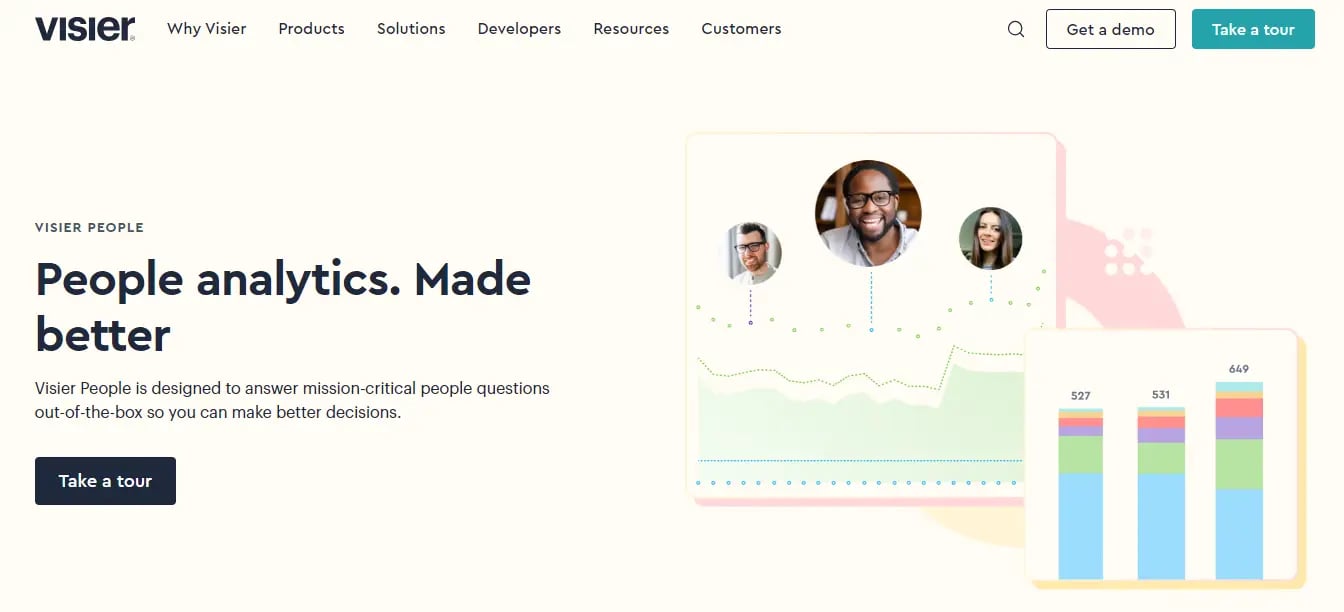 Visier's people analytics software gives you the power to track organizational changes in real-time, using detailed data on new hires, exits, and your workforce's overall evolution. This technology revolutionizes HR, making it more dynamic and better equipped to handle today's workforce needs. It allows you to go beyond simple measurements, exploring every aspect of an employee's experience from the moment they apply through their development to when they leave the company.
Visier's people analytics software gives you the power to track organizational changes in real-time, using detailed data on new hires, exits, and your workforce's overall evolution. This technology revolutionizes HR, making it more dynamic and better equipped to handle today's workforce needs. It allows you to go beyond simple measurements, exploring every aspect of an employee's experience from the moment they apply through their development to when they leave the company.
Key Features:
- A vast range of ready-to-use and customizable content.
- Integrated tools for quick and precise insights.
- Facilitates HR activities throughout an employee's time with the company, from recruitment to offboarding.
- Tracks and reports on the overall health and efficiency of the organization.
- Makes it easier to connect with external HR systems for comprehensive employee, facilities, and benefits management.
Founding Year: 2010
G2 Rating: 4.6/5 (121 reviews)
Pricing: NA
4. Oracle
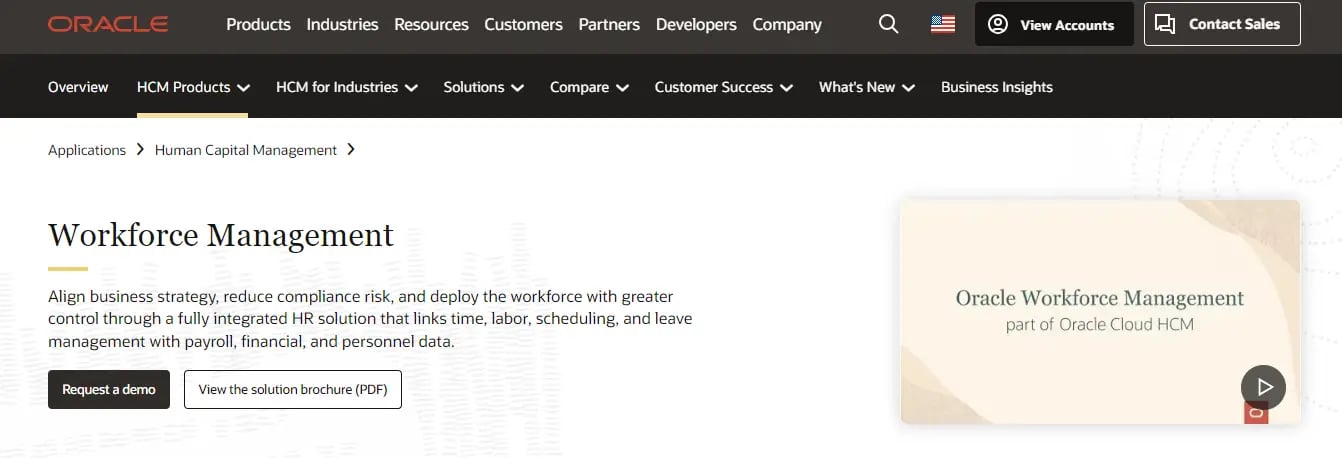 Oracle's Human Capital Management (HCM) system synchronizes business strategy and minimizes compliance risks. It offers a fully integrated HR solution that enhances workforce management. This system connects various aspects like time and labor management, scheduling, and leave management with critical payroll, financial, and personal data, allowing for more streamlined and controlled workforce deployment.
Oracle's Human Capital Management (HCM) system synchronizes business strategy and minimizes compliance risks. It offers a fully integrated HR solution that enhances workforce management. This system connects various aspects like time and labor management, scheduling, and leave management with critical payroll, financial, and personal data, allowing for more streamlined and controlled workforce deployment.
Key Features:
- Enable managers to see labor needs and differences in real-time, assisting them in making the best scheduling decisions.
- Allow eligible workers to choose their shifts and give them the option to pick up, give up, or exchange shifts with a qualified colleague.
- Ensure adherence to intricate rules, including those related to managing fatigue, maintaining fairness based on seniority, and meeting schedule predictability standards.
- Boost efficiency, communication, and involvement by offering employees a single platform where they can handle all their scheduling needs.
Founding Year: 1977
G2 Ratings: 3.5/5 (524 reviews)
Pricing: Different pricing options for SMBs and Enterprises
| Explore the essential steps to implement skills-based workforce planning to align talent with business needs and optimize workforce efficiency. |
5. ClickUp
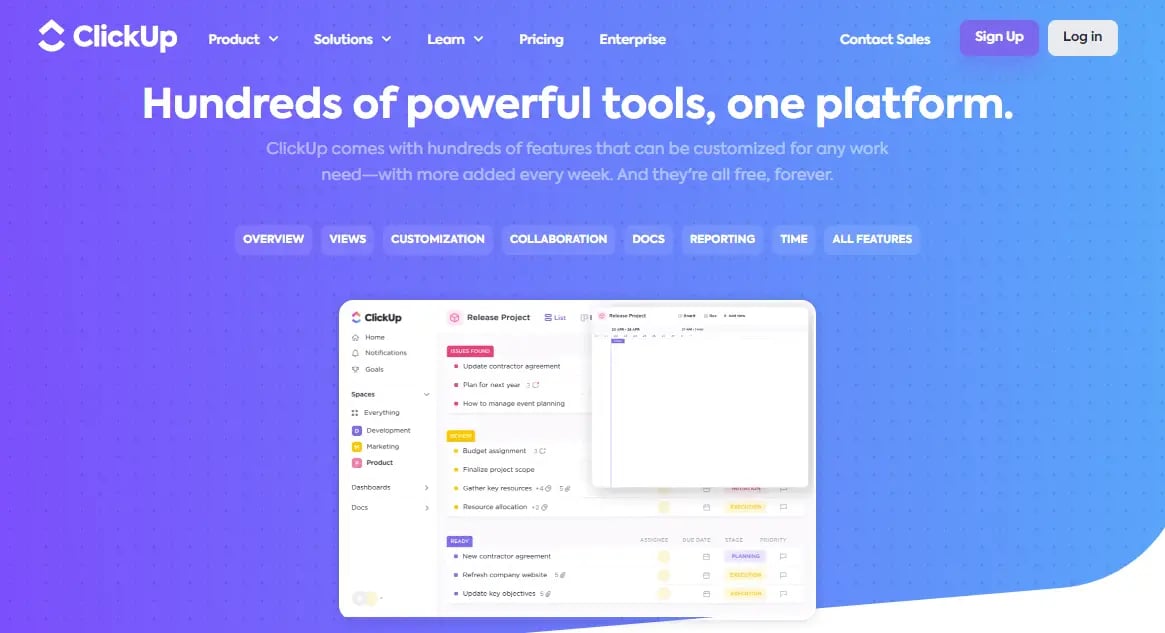 ClickUp's distinctive Hierarchy system allows you to build an ideal organizational structure that grows with your requirements. Every layer in ClickUp offers increased flexibility and control, making it suitable for organizing everything from small teams to large enterprise companies.
ClickUp's distinctive Hierarchy system allows you to build an ideal organizational structure that grows with your requirements. Every layer in ClickUp offers increased flexibility and control, making it suitable for organizing everything from small teams to large enterprise companies.
Key Features:
- Enables administrators to tailor the system to fit their specific workflows.
- Streamlines a multi-step process that usually needs input from various users, automating it for efficiency.
- Provides controlled access to specific data, features, and objects depending on the user's role, groups, and other criteria.
- Facilitates the consumption, publication, and modification of content through a unified interface.
Founding Year: 2017
G2 Rating: 4.7/5 (9,231 reviews)
Pricing: ClickUp has five pricing editions. A free trial of ClickUp is also available.
6. Runn
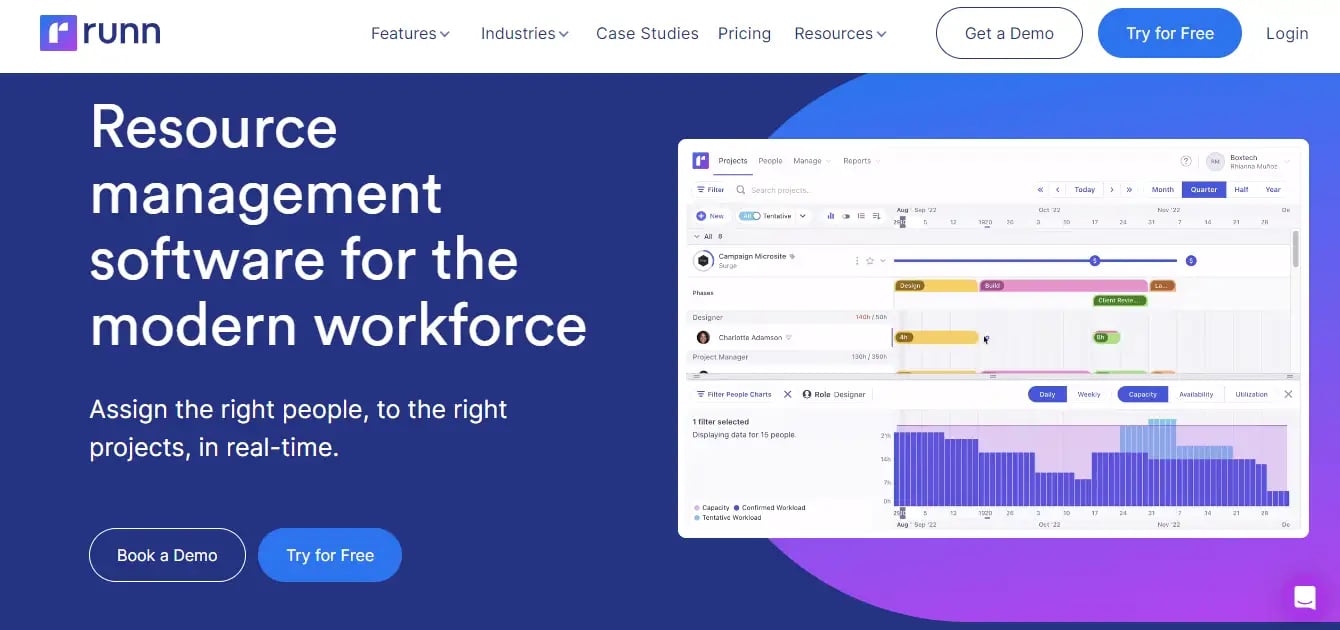 Runn is a dynamic resource management tool that includes built-in time tracking and robust forecasting features. It offers clear insights into project schedules, team members' time, and the overall health of the business, helping to coordinate teams effectively.
Runn is a dynamic resource management tool that includes built-in time tracking and robust forecasting features. It offers clear insights into project schedules, team members' time, and the overall health of the business, helping to coordinate teams effectively.
Key Features:
- Effortlessly organize projects and assign resources for both immediate and future needs.
- Gain a comprehensive overview that allows you to manage capacity, workload, and availability in real-time.
- Runn maps out potential projects, giving you a preview of how your plans could shift if those projects are approved.
- Forecast capacity, projects, scenarios, and financials.
Founding Year: 2018
G2 Rating: 4.5/5 (1 review)
Pricing: Runn has three pricing editions. A free trial of Runn is also available.
|
Finding it difficult to identify the ideal candidates for internal mobility? Ease the process by precisely matching employees' skills to open roles with iMocha's Skill Intelligence platform. |
7. Planful
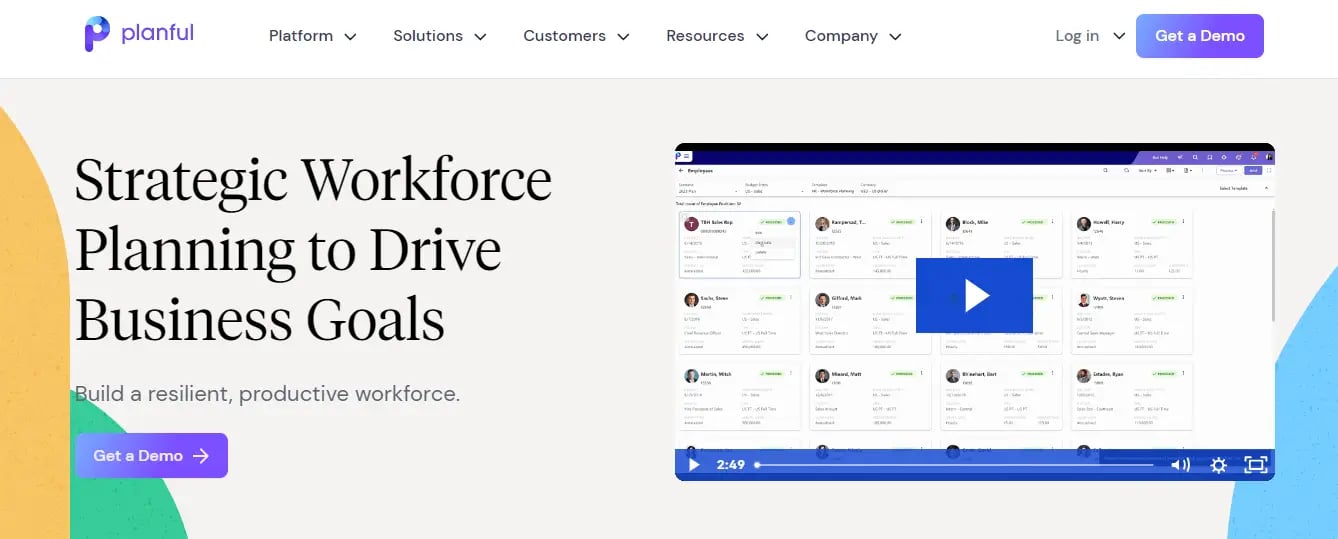 Planful offers comprehensive cloud software for financial close, consolidation, and financial planning & analysis (FP&A). CFOs and financial teams worldwide use the Planful platform to simplify and integrate processes like planning, budgeting, consolidating, reporting, and visual analytics across their businesses. Planful is known for speeding up processes, enhancing productivity, and boosting accuracy throughout the entire FP&A cycle.
Planful offers comprehensive cloud software for financial close, consolidation, and financial planning & analysis (FP&A). CFOs and financial teams worldwide use the Planful platform to simplify and integrate processes like planning, budgeting, consolidating, reporting, and visual analytics across their businesses. Planful is known for speeding up processes, enhancing productivity, and boosting accuracy throughout the entire FP&A cycle.
Key Features:
- Rapid assistance when needed
- The Spotlight XL EBR is highly effective and easy to use
- Successful integration of the BOOMI tool with ERP, enhancing seamless connections with other platforms
- Row and column sets in reports are straightforward and clear
- The new AI features seem beneficial and intuitive for users
Founding Year: 2000
G2 Rating: 4.3/5 (382 reviews)
Pricing: NA
8. Planday
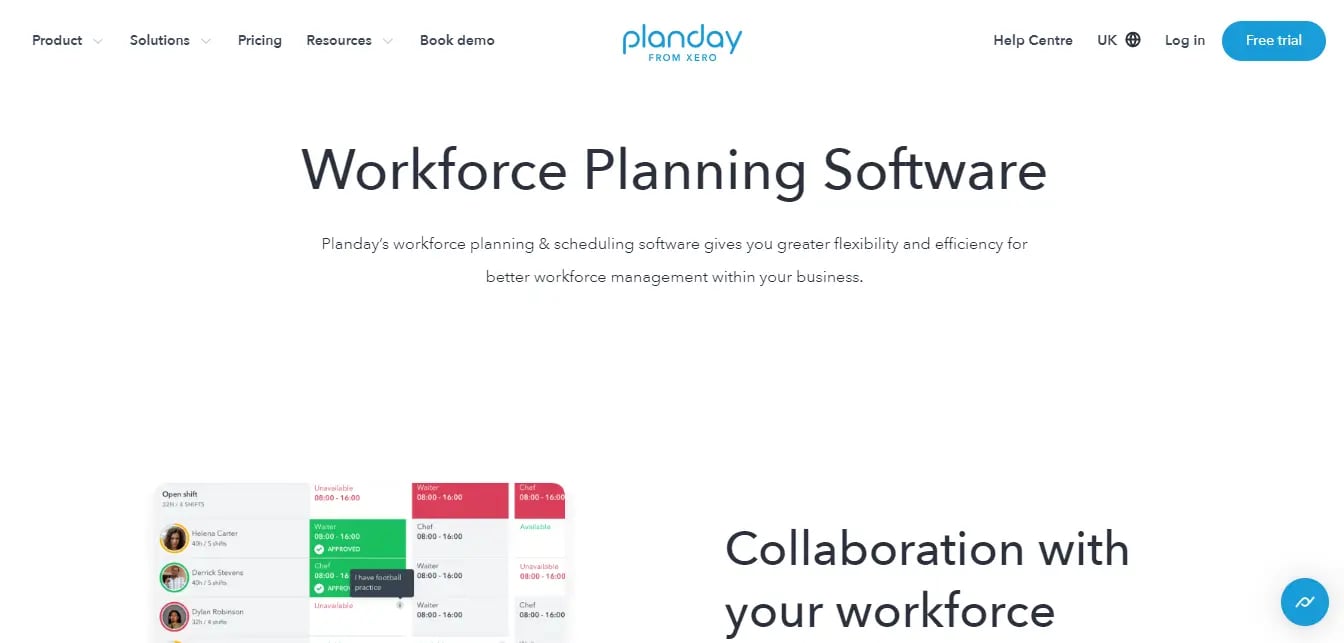 Planday is a workforce planning platform designed to enable managers and employees to collaborate more effectively and work more efficiently. Planday simplifies various manual staff management tasks like schedule creation, staff cost control, monitoring time and attendance, and payroll preparation. It ensures all team members are constantly connected, facilitating immediate shift adjustments, updates, and optimization. This keeps you in command of your business operations.
Planday is a workforce planning platform designed to enable managers and employees to collaborate more effectively and work more efficiently. Planday simplifies various manual staff management tasks like schedule creation, staff cost control, monitoring time and attendance, and payroll preparation. It ensures all team members are constantly connected, facilitating immediate shift adjustments, updates, and optimization. This keeps you in command of your business operations.
Key Features:
- Enables administrators to tailor the system to suit their specific workflows.
- Defines the method for the application to interact with other software.
- Allows users to access and conduct business in various languages and currencies, providing a multi-lingual and multi-currency experience.
- Provides controlled access to certain data, features, and objects based on user identity, roles, and group memberships.
Founding Year: 2013
G2 Rating: 4.5/5 (86 reviews)
Pricing: Planday has four pricing editions. A free trial of Planday is also available.
9. Anaplan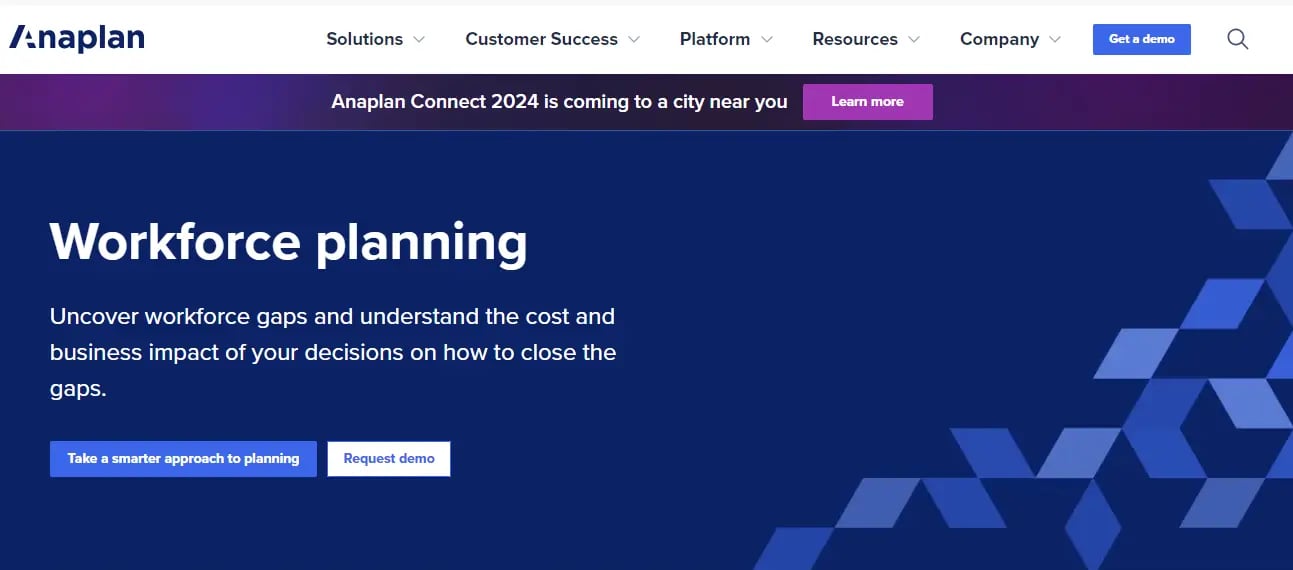
Anaplan offers a revolutionary approach to visualizing, planning, and operating your business. Leveraging its unique Hyperblock™ technology, Anaplan provides real-time insights and predictive forecasting to enhance swift and assured decision-making. It facilitates integrated strategy and planning throughout your organization, propelling your business ahead.
Key Features:
- Gives administrators the flexibility to modify the system to fit their specific operational processes.
- Features an Application Programming Interface (API) that outlines how the application interfaces with other software.
- Supports multi-language and multi-currency functionality, allowing users to view and conduct transactions in various languages and currencies.
- Enables selective access to specific data, features, and objects tailored to user identities, roles, and group affiliations.
Founding Year: 2006
G2 Rating: 4.6/5 (342 reviews)
Pricing: Basic, Professional, and Enterprise pricing options.
10. ChartHop
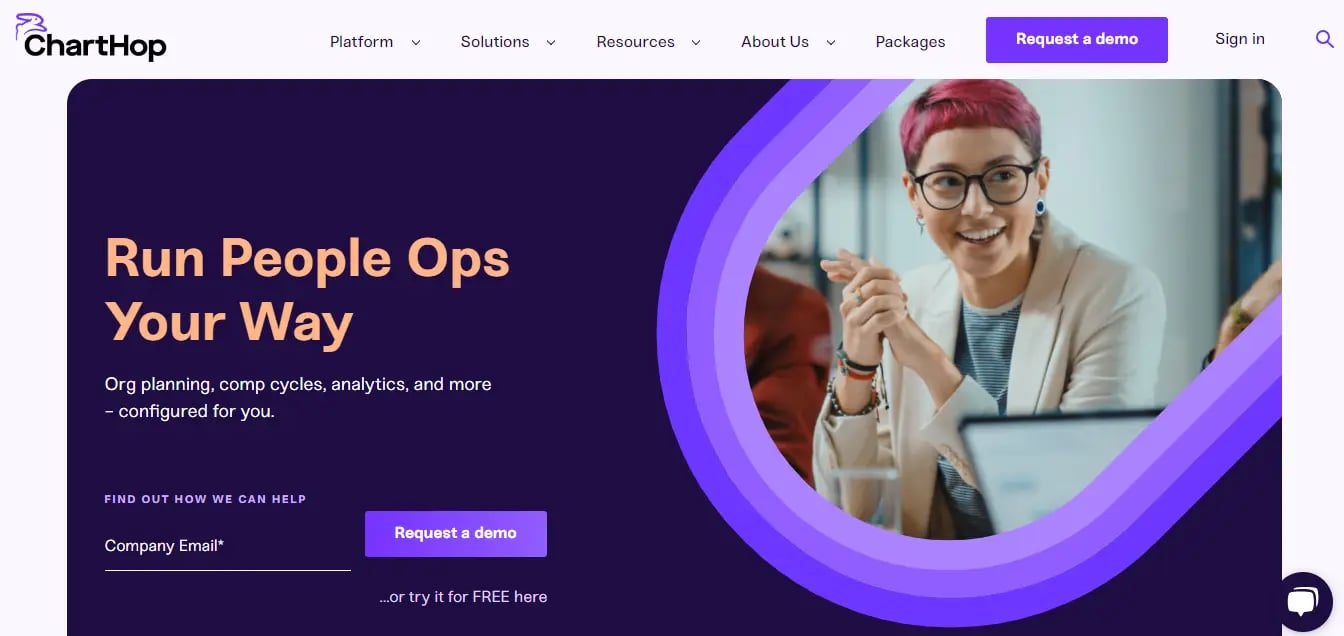 ChartHop is dedicated to fostering open and healthy communication within companies, ensuring both employees and the organization prosper. As a vibrant People Operations Platform, ChartHop integrates and illustrates personnel data, enabling businesses to grow through informed insights, strategic alignment, and decisive action. Revolutionizing HR practices, ChartHop's platform is a central hub for all people-related data and is the go-to resource for everyday operations, programs, and initiatives.
ChartHop is dedicated to fostering open and healthy communication within companies, ensuring both employees and the organization prosper. As a vibrant People Operations Platform, ChartHop integrates and illustrates personnel data, enabling businesses to grow through informed insights, strategic alignment, and decisive action. Revolutionizing HR practices, ChartHop's platform is a central hub for all people-related data and is the go-to resource for everyday operations, programs, and initiatives.
Key Features:
- Arranges employees within a company framework that is applied across the application for reporting, access rights, and more.
- Monitors working hours, attendance, vacation days, sick leave, work schedules, and other relevant workforce details.
- Includes features for employees to file expense reports and monitor their reimbursements.
- Handles job descriptions and salary scales/structures for every position.
Founding Year: 2019
G2 Rating: 4.2/5 (103 reviews)
Pricing: ChartHop has two pricing editions.
|
Still unsure about the skills within your workforce? Get a crystal-clear view of your employees' capabilities with our Skill Intelligence Platform. |
11. Board
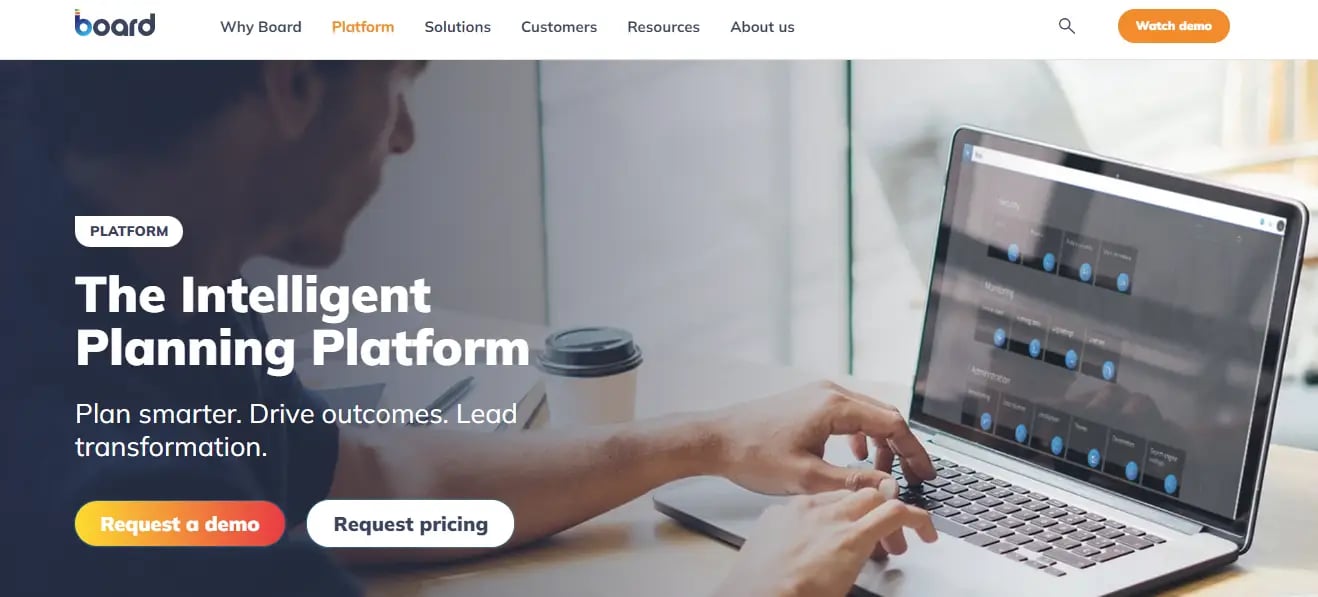 Board assists prominent companies in integrating their strategy, finance, and operations with smarter planning methods, ensuring complete control over performance. Through collaboration with Board, international firms like H&M, BASF, Burberry, Toyota, Coca-Cola, KPMG, and HSBC have revolutionized their planning procedures digitally.
Board assists prominent companies in integrating their strategy, finance, and operations with smarter planning methods, ensuring complete control over performance. Through collaboration with Board, international firms like H&M, BASF, Burberry, Toyota, Coca-Cola, KPMG, and HSBC have revolutionized their planning procedures digitally.
Key Features:
- The reporting interface for both standard and self-service reports is user-friendly and straightforward.
- Answers to business queries can be found with just a few steps or clicks.
- Provides a range of appealing graph and chart styles for data presentation.
- Features scorecards that visually monitor Key Performance Indicators (KPIs).
Founding Year: 1994
G2 Rating: 4.4/5 (288 reviews)
Pricing: NA
12. Quinx
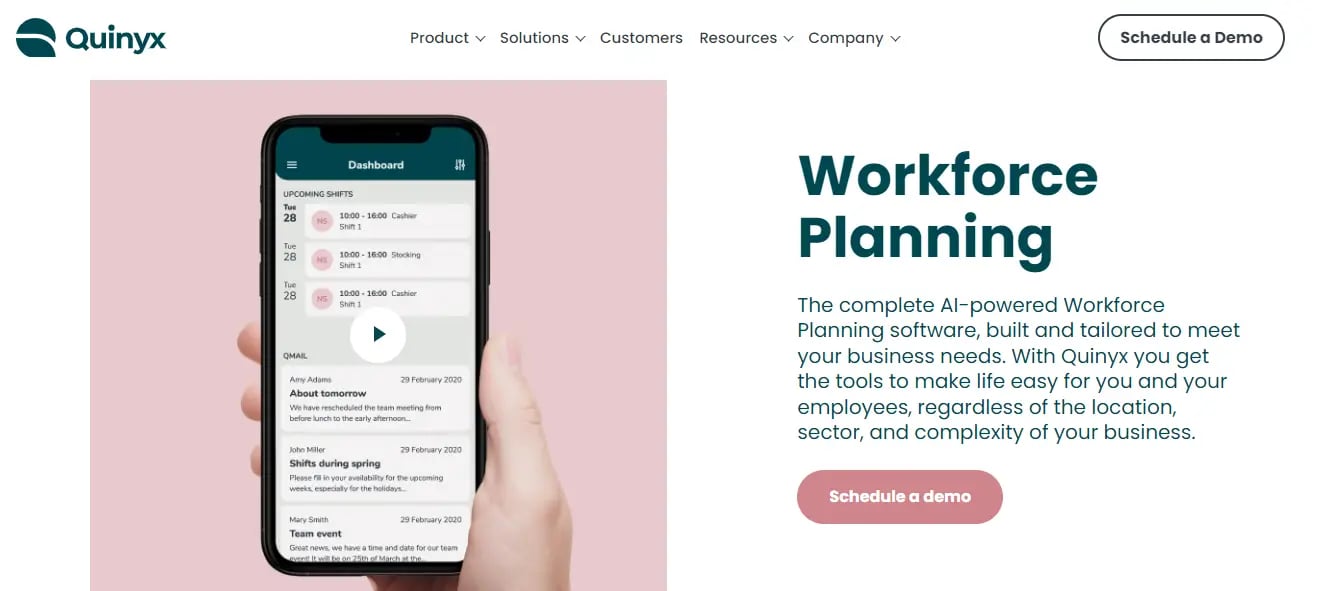 Quinx is an All-in-One Frontline Platform that simplifies labor forecasting, optimizes schedule management, and boosts employee engagement. This leads to significant reductions in overtime and enhancements in profitability. Managers gain more time to lead their teams, resulting in higher productivity and employee engagement.
Quinx is an All-in-One Frontline Platform that simplifies labor forecasting, optimizes schedule management, and boosts employee engagement. This leads to significant reductions in overtime and enhancements in profitability. Managers gain more time to lead their teams, resulting in higher productivity and employee engagement.
Businesses that depend on a frontline workforce and seek to optimize their operations, manage their workforce effectively, and engage their frontline employees can greatly benefit from Quinyx's solutions.
Key Features:
- Allows administrators to tailor the system to fit their specific operational needs.
- Features an Application Programming Interface (API) that details how the application interacts with other software.
- Supports multi-language and multi-currency functionalities, allowing users to access and conduct business in different languages and currencies.
- Enables selective access to specific data, features, and objects determined by the user's role, group membership, and other criteria.
Founding Year: 2005
G2 Rating: 4.2/5 (390 reviews)
Pricing: NA
13. Workday HCM
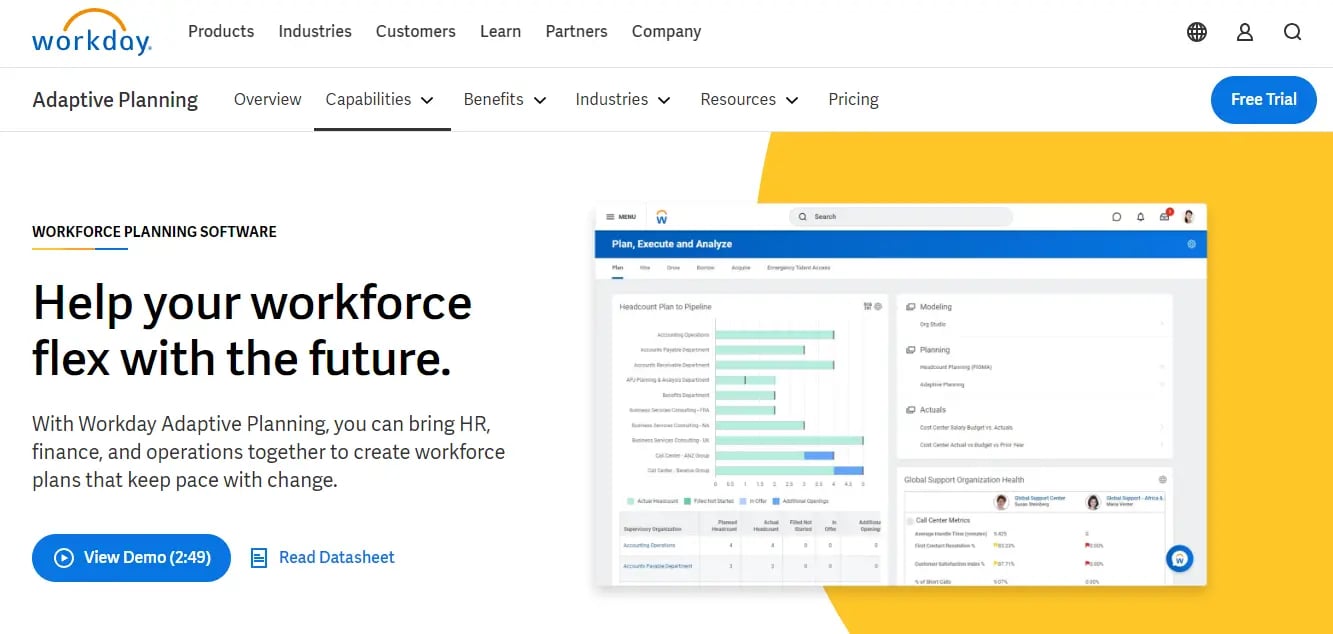 Workday HCM offers a cohesive, cloud-based system for workforce planning, talent management, and payroll, equipping organizations to thrive in a changing world. Integrated with advanced artificial intelligence and machine learning, its applications are built to help global organizations adapt to the shifting work landscape.
Workday HCM offers a cohesive, cloud-based system for workforce planning, talent management, and payroll, equipping organizations to thrive in a changing world. Integrated with advanced artificial intelligence and machine learning, its applications are built to help global organizations adapt to the shifting work landscape.
Key Features:
- Workday Skills Cloud utilizes machine learning to effectively align skills with appropriate opportunities, allowing organizations of all sizes to enhance their workforce flexibility dynamically.
- The platform's advanced analytics provide deep insights into large data sets, offering clear, narrative-style explanations of current situations and their underlying causes.
- It simplifies the entire hiring to payment process through intelligent automation, greatly minimizing manual tasks.
- With its extensive compensation and benefits options, the platform enables the creation of customized plans tailored to the varied needs of your workforce, ensuring that employees are adequately recognized and rewarded.
Founding Year: 2005
G2 Ratings: 4/5 (1295 reviews)
Pricing: NA
| Unlock the potential of a skills-based workforce to enhance your workforce planning process. |
14. SAP SuccessFactors
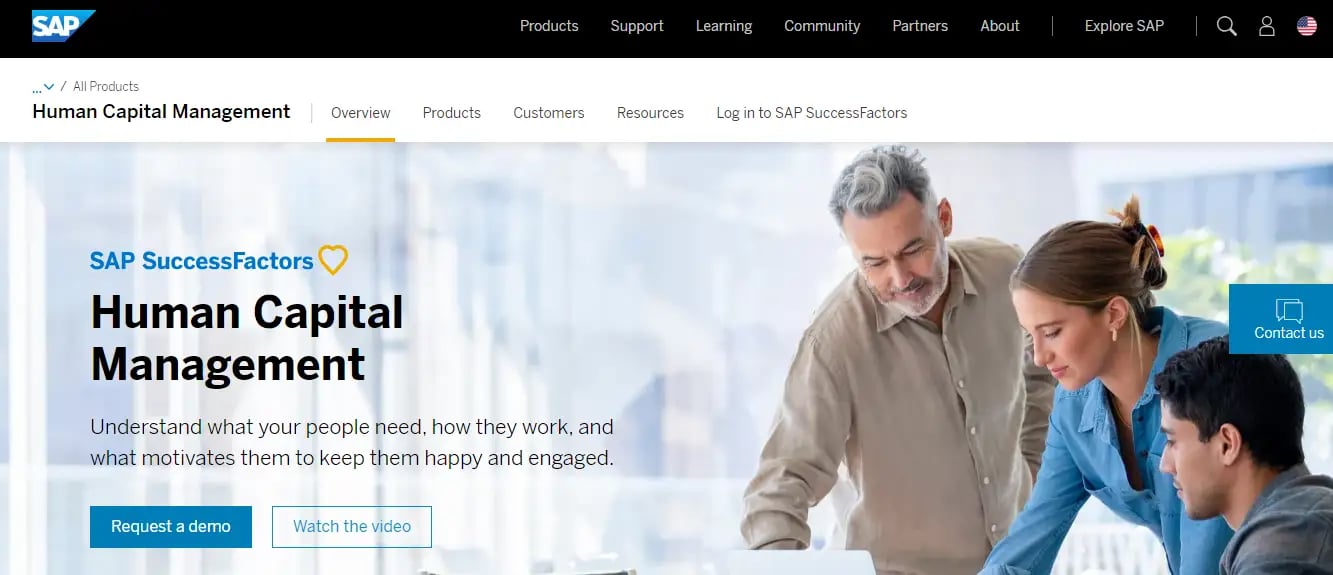 SAP SuccessFactors solutions are revolutionizing the workplace by enhancing the link between HR and business operations, aiding organizations in building a sustainable workforce and a profitable enterprise. The Human Experience Management (HXM) suite from SAP SuccessFactors spans various domains such as core HR/payroll, talent management, HR analytics/workforce planning, and personalized employee experiences, supporting both employees and companies in achieving their optimum potential.
SAP SuccessFactors solutions are revolutionizing the workplace by enhancing the link between HR and business operations, aiding organizations in building a sustainable workforce and a profitable enterprise. The Human Experience Management (HXM) suite from SAP SuccessFactors spans various domains such as core HR/payroll, talent management, HR analytics/workforce planning, and personalized employee experiences, supporting both employees and companies in achieving their optimum potential.
Key Features:
- Employee Experience Management
- Core HR and Payroll
- Talent Management
- HR Analytics and Workforce Planning
Founding Year: 2001
G2 Rating: 3.9/5 (655 reviews)
Pricing: NA
15. ActivTrak
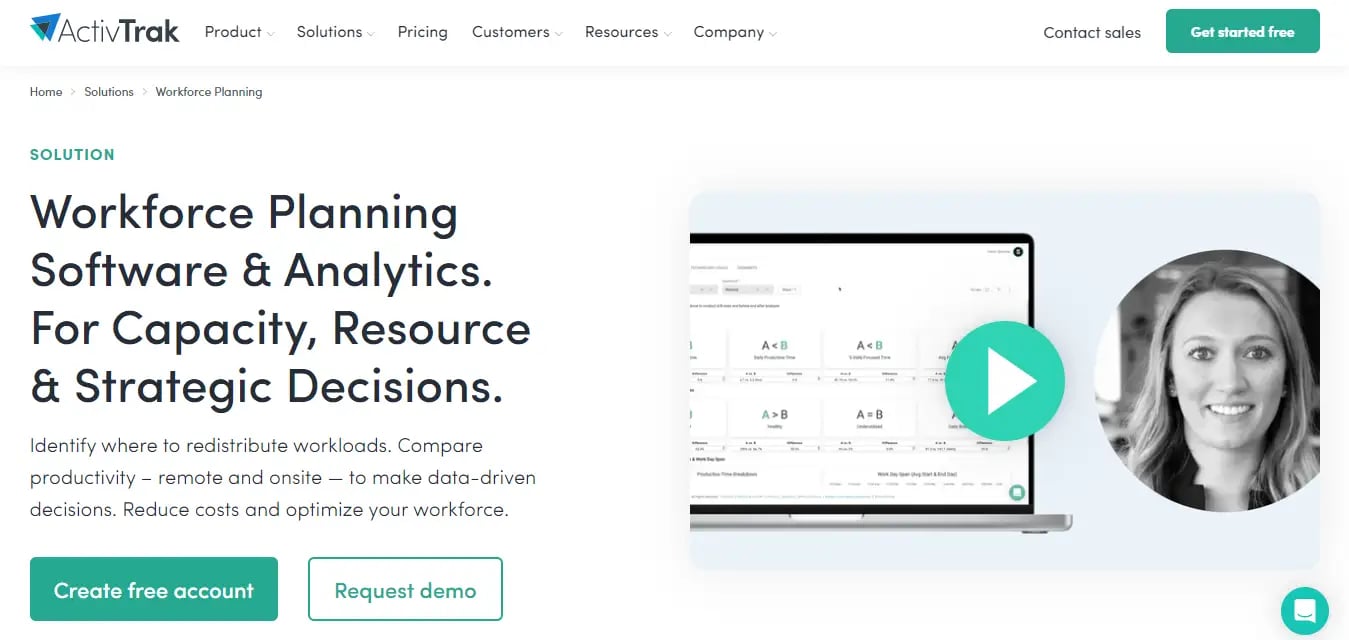 ActivTrak is workforce planning software that aids both employers and employees in collaborating more effectively to achieve their maximum potential. Its cloud-based workforce analytics offer clarity and valuable insights into people, processes, and technology, assisting organizations in making informed decisions and enhancing results.
ActivTrak is workforce planning software that aids both employers and employees in collaborating more effectively to achieve their maximum potential. Its cloud-based workforce analytics offer clarity and valuable insights into people, processes, and technology, assisting organizations in making informed decisions and enhancing results.
Key Features:
- Enables users to categorize and arrange their endpoints for collecting targeted threat intelligence on specific technologies.
- Minimizes repetitive tasks for IT and security experts in acquiring threat data.
- Alerts users about new, pertinent vulnerabilities or threats before security incidents occur.
- Offers the capability for users to generate reports with detailed and customized threat information.
Founding Year: 2009
G2 Rating: 4.4/5 (244 reviews)
Pricing: ActivTrak has three pricing editions, from $0 to $17. A free trial of ActivTrak is also available.
16. Empxtrack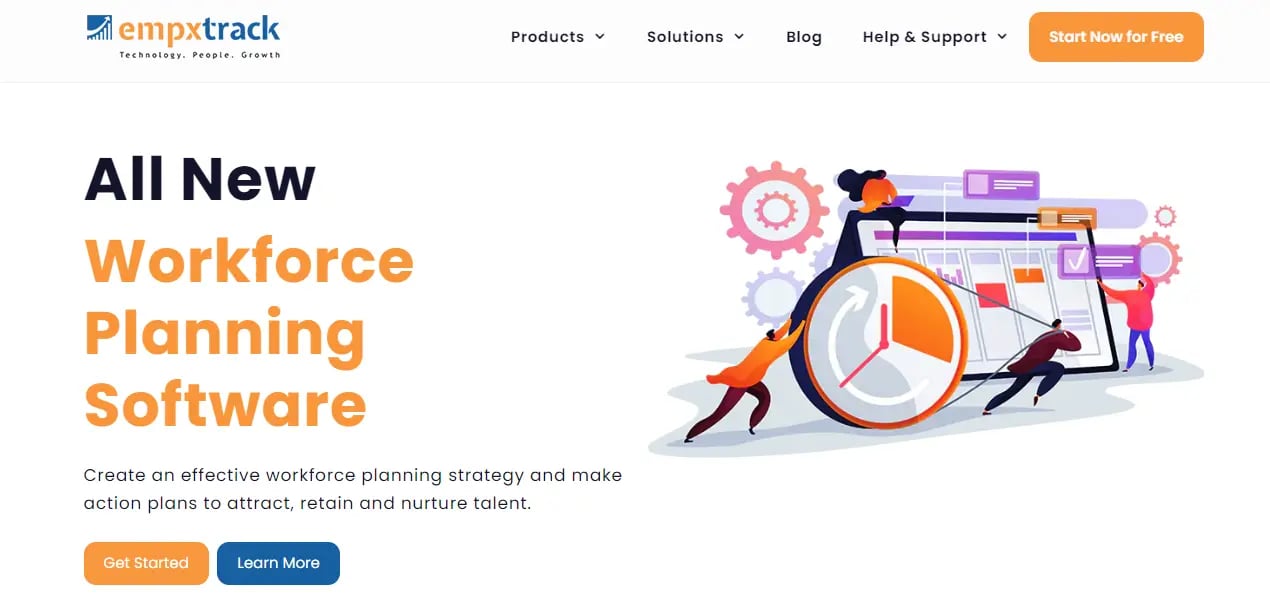
The Empxtrack workforce planning tool offers a comprehensive online self-service portal for both employees and HR. Through the Empxtrack employee self-service portal, employees can handle HR-related tasks independently, significantly reducing the administrative load on HR professionals.
Key Features
- An employee self-service portal that is easily customizable and user-friendly.
- Enhances workforce engagement and empowerment with an employee self-service portal.
- Reduces inquiries and promote clear information access.
- Boosts HR productivity through the use of a self-service portal.
Founding Year: 2004
G2 Rating: 4.5/5 (2 reviews)
Pricing: NA
| Discover the advantages of workforce planning to drive business growth and enhance talent management. |
Conclusion
Various workforce planning tools, including strategic workforce planning software and headcount planning software, assist HR teams and decision-makers make data-driven choices for their workforce. Solutions like iMocha not only aid in making decisions that contribute to an organization's growth but also enhance employee development, which in turn boosts employee retention rates.
We trust this blog has guided you in selecting the appropriate workforce planning tool for your organization. For more insightful articles, remember to subscribe to our blog page. Should you have any queries, feel free to contact us at marketing@imocha.io.
|
Are you struggling to identify the skills needed to stay ahead of your competition? Try iMocha! |
FAQs
What is strategic workforce planning?
Strategic workforce planning is an essential process for assessing the present skills of employees and anticipating their future requirements.
It is a data-driven method that utilizes specialized workforce planning software to pinpoint the discrepancy between the existing skills of the workforce and what will be needed in the future.
They also assist in devising strategies to bridge this gap, enhance employee engagement, and increase retention rates.
What does workforce planning software do?
Workforce planning software helps businesses make choices based on facts. These tools gather information about your employees and make reports and predictions to help you figure out what kind of staff and resources you'll need in the coming months.
These tools have features for analyzing data and making reports. They do more than just count employees; they can also track things like how often employees leave, their skills, and future labor needs. Companies can use this information to change their plans as needed.
| Discover the Top 15 Workforce Planning Metrics to track organizational readiness and address talent gaps. |
Why is data important for workforce planning?
Data is crucial for workforce planning for several reasons:
- Data provides a factual basis for decisions, moving away from guesswork and assumptions.
- Data helps in pinpointing existing skills within the workforce and identifying gaps. This is essential for training, hiring, and development strategies to ensure the workforce can meet current and future business needs.
- Through data analysis, organizations can predict future workforce requirements, like how many employees and what skill sets will be needed, helping in long-term planning and budgeting.
- Data can highlight areas of inefficiency or underperformance in the workforce. This insight allows organizations to implement targeted improvements, leading to better productivity.
- Data aids in understanding employee trends, like turnover rates, which can inform retention strategies and talent acquisition.
- Data ensures that workforce planning aligns with the overall business strategy, ensuring that the right people are in the right roles at the right time to achieve business goals, and much more.


